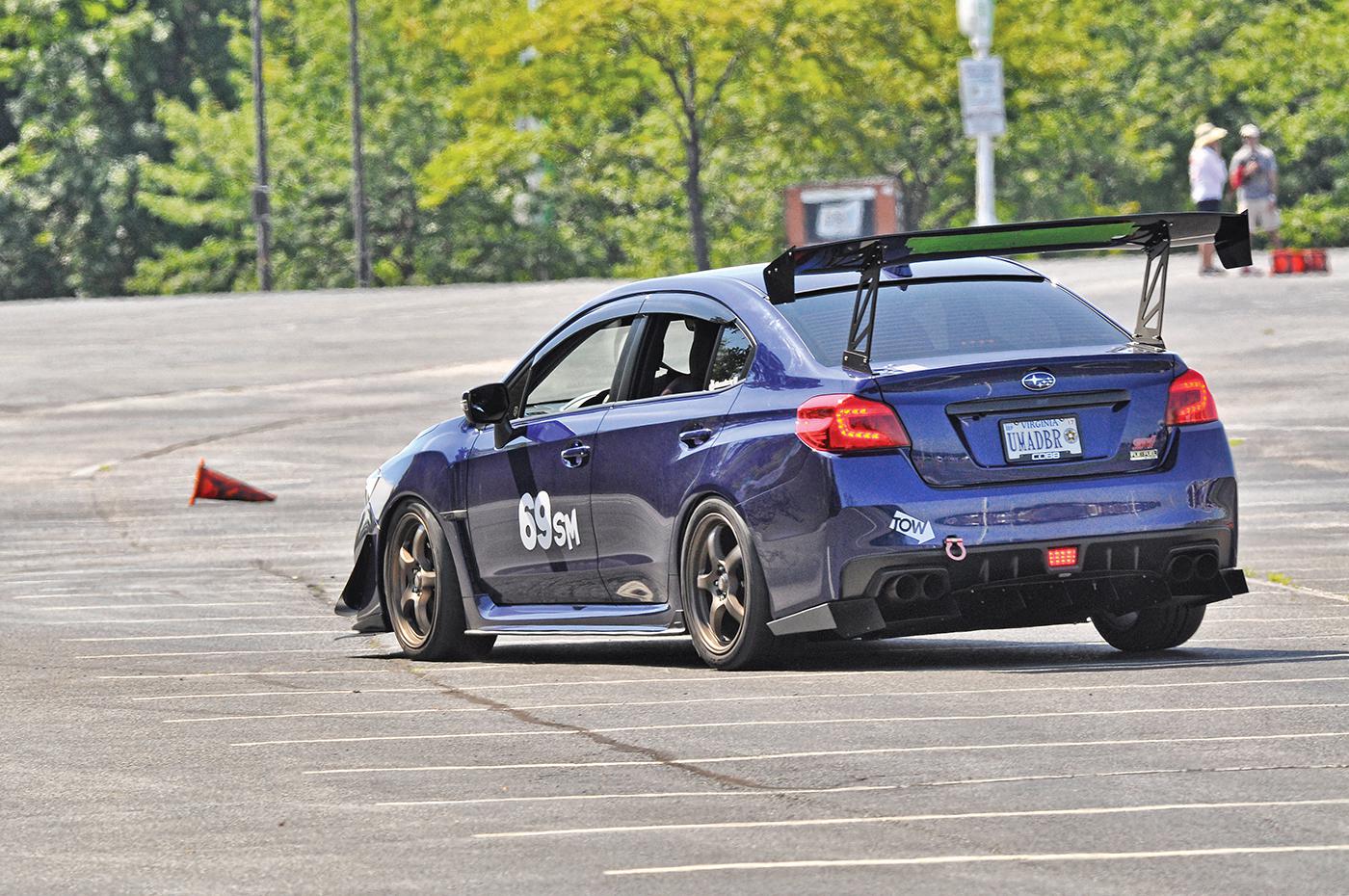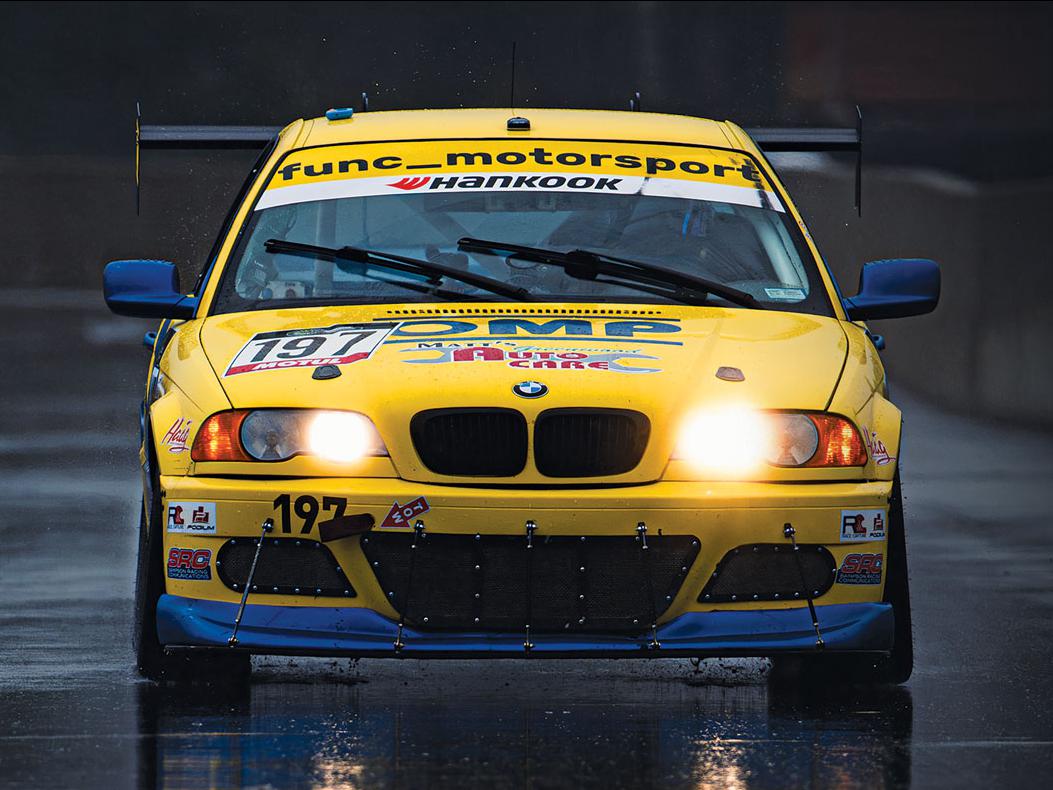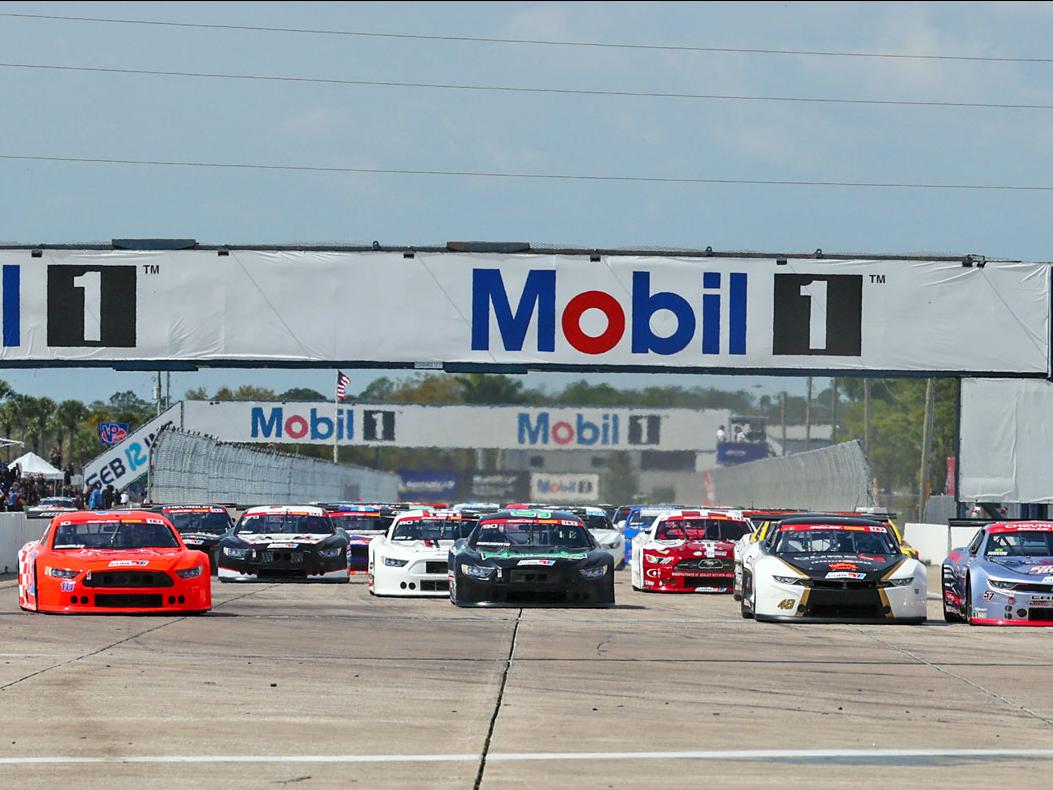AUTOCROSS: HONING THE SETUP

Featuring a relatively simple format with low barriers to entry, this precision-focused discipline is flush with opportunity for suppliers and performance-improvement shops alike.
Typically held in parking lots or rented air strips with a course lined out by way of safety cones, autocross is often considered a steppingstone on the path to road course disciplines like time trials and wheel-to-wheel club racing. But while autocrossing undoubtedly has grassroots appeal in that sense, it’s also a legitimate racing segment all its own, with both a clear path up the ranks of competition as well as distinctive strategies in both racing technique and car setup that stand apart from its road course-based counterparts. And those characteristics have contributed to the lasting, undeniable appeal of autocross for competitors across the country and beyond.
“We’ve got about 65,000 members in the Sports Car Club of America, and more than half of them cite autocross as their primary interest,” explained Bob Tunnell, multi-time SCCA Solo national champion and Topeka, Kansas-based SCCA Time Trials national series competition director. “That’s a lot of people, and a lot of opportunity for the aftermarket.”
As OEMs raise the bar for production vehicle capability and enthusiasts look for challenges that go beyond the stoplight drags, autocross has seen a noticeable rise in popularity in recent years. “There is a growing scene in autocross,” said Nicholas Madara of Automotive Performance & Chassis, Cary, North Carolina. “The events are huge, and in general we’re noticing that people are paying attention to how their cars are handling, and what kind of tires they are putting on their cars, now more so than ever before.”
While part of the appeal is the relative simplicity of the format, the specialized character of autocross lends itself to car setups, modifications, and maintenance routines that are tailored specifically to it, rather than being simply carried over from traditional road course tactics. Here, we’ll take a closer look at the details to see how autocross competitors are honing their programs in the never-ending quest for quicker lap times.
Multifaceted Appeal
Part of autocross’s popularity can also be attributed to logistical considerations. Since these events normally aren’t held at race tracks, organizers have much more freedom in terms of where and when they are held, and the costs of allocating parking lot or runway space usually pale in comparison to those of road courses earmarked for officially sanctioned competition. That equates to entry fees that can be a fraction of the cost of road-course events, whether that’s a wheel-to-wheel club race or simply a track day test-and-tune.
The accessibility of autocross is further aided by the fact that these racers can compete in a garden-variety street car, if they choose to do so, which in turn translates into a much lower cost of entry to get started in the discipline. “It’s inexpensive, it’s relatively low risk, and it’s a low amount of time commitment as well,” said Dave Whitworth of the National Auto Sport Association, Las Vegas, Nevada. “Even if a car isn’t competitive—if it’s safe, you can run it. And since most entry-level events are one-day programs rather than a race weekend, and they’re normally held all over the country every weekend, you can avoid travel expenses as well.”
Don’t mistake autocross competition for a glorified car control clinic, though. “It demands a lot of focus, and it’s very competitive—I would say even more so than time trials,” Tunnell said. “There are so many more decision points crammed into a 60-second run than there are on a two-and-half-mile road course. I remember hearing from a racer who started in autocross and eventually moved up to the highest levels of professional road racing. After a few seasons, he dropped me a note saying that he missed the intensity of autocross. With autocross there’s never a moment where you can relax, where you aren’t fully focused on the run.”
It’s also important to note that autocross is not exclusively an entry-level enterprise—sanctioning bodies have well-established frameworks for racers to move into more advanced competition as their programs and experience mature, with classes that range from ostensibly factory-stock street cars to near-unlimited classes that are populated with tube-chassis, purpose-built race cars. “[My wife] Patty and I have been competing in autocross since 1983, and it’s every bit as meaningful and challenging to us today as it was when we were just getting started,” Tunnell added.
Safety
Another important factor in autocross that provides significantly more accessibility in comparison to competitive road-course disciplines is the circumstances that facilitate its low safety equipment requirements, which can otherwise be costly and prohibitive for folks who might consider using their daily-driven vehicles in competition.
“You basically need a properly functioning vehicle with seat belts, along with a helmet and closed-toed shoes,” said Whitworth. “Because your speeds are relatively low and there are no stationary objects or other cars to hit on course, the safety equipment that works on the highway generally works pretty well on an autocross course.”
But that doesn’t mean competitors are prohibited from adding equipment that might not only make them safer, but also faster. “They aren’t required, but there are several advantages to safety equipment like six-point harnesses,” said John Haydon of Pegasus Auto Racing Supplies, New Berlin, Wisconsin. “That will definitely help to hold the driver in the seat, which means more of your focus is on your inputs rather than fighting to keep yourself in place as you’re driving.”
Roll bars and cages generally aren’t required either, but they do provide another significant measure of safety while also stiffening the chassis, thus improving the car’s overall handling by preventing the suspension geometry from changing when subjected to high cornering loads.
Car Setup
Although handling and grip are top priorities in both autocross and road course racing, there are some important factors that distinguish the former from the latter. “You’re setting the car up for quick bursts of speed, and handling response that’s a bit dartier than you’d typically find on a car tuned for the road course,” said Madara.
Some of that comes down to tire choice, but sanctioning bodies generally limit competitors’ options to a specific treadwear rating to keep relative parity within a given class. In many of the lower “street” classes, where allowed modifications are highly restricted, alignment tuning plays a significant role as competitors look for ways to shave off tenths without running afoul of the rulebook. “There are no slaloms on a road course, and that kind of transitional handling is really important on an autocross course,” Tunnell noted. “So racers spend an inordinate amount of time playing with alignments. You’ll frequently see folks at events with a set of jack stands and a string around the car doing adjustments.”
That generally equates to additional negative camber and more toe-out, said Whitworth. “You’ll see a lot of autocross cars that run toe out in the front to help the car turn in faster, but that kind of setup would be terrible on a road race car when you’re on a long straight.”
Moving up the ranks to the mid-level classes, where competitors have more freedom to make modifications, suspension changes are normally the focal point. “Spring rates tend to be stiffer than stock, but they’re still softer than you’d normally use on a road race setup,” Tunnell said. “The surfaces in a parking lot or airstrip tend to be much bumpier than your typical road course, so the suspension also has to be a bit forgiving or you sacrifice stability. Shock settings are really crucial.”
And suspension tuning goes hand in hand with modification. “Spec alignments, ride height adjustments, and corner balancing with digital scales are all common services we provide for our autocross customers,” said Madara. “Aftermarket springs and sway bars are popular upgrades with these cars, along with polyurethane bushings.”
Factory bushings are typically made from a rubber compound, which is designed to provide compliant ride quality characteristics in street-driven cars. But that compliance also allows for more deflection over bumps, causing the alignment to change as the car moves around. Switching to a polyurethane bushing reduces that deflection tendency, further improving the predictability of the car’s handling and overall response.
Braking performance is also an important consideration. But unlike road-course setups, where effective heat management over prolonged use is perhaps the most essential characteristic, the format of autocross de-emphasizes thermal management. “It’s not uncommon to see folks in the upper classes, where you’re allowed to make significant changes to your brake system, to actually move to a smaller brake system to save weight,” said Tunnell. “The demands on the brake system in autocross in terms of heat dissipation are far lower, so there’s not much point to lugging around big rotors and big calipers if you don’t need them.”
Responsiveness from the brake system is needed, however, so pad choice is perhaps the most critical component in the system. “You don’t have a pace lap to warm the brakes up to operating temperature, like you would in a road race,” Haydon said. “So you need a brake pad that will be effective right away, when it’s still cold. Compounds like the Hawk HP+, which was developed specifically for autocross use, provide much higher friction levels than a street pad while also operating at much lower temperatures than road racing pads do.”
At the higher levels of autocross competition, where the modification rules are generally the least restrictive and purpose-built powertrains are common, aerodynamics also play a significant role. But in contrast to road racing aero packages, which normally seek to balance drag and stability at triple-digit speeds, autocross aero is an entirely different animal. “In the higher prep levels, aero is required to be competitive—if it’s allowed in your class, you’re going to want to do it,” said Whitworth. “Drag isn’t really a factor at these speeds—the main goal is downforce, so your aero has to be optimized to do as much as it can in that regard.”
Tunnell noted that while the aero used at this level of competition is not the kind of stuff found in an OEM parts catalog, there are resources that can help racers figure out what they need. “You don’t have to be an aerodynamicist to have good aero these days—there are so many companies making really efficient bits and pieces that you can put together,” he said. “You have to be careful to make sure you’re not buying something that’s simply cosmetic—there’s a lot of that stuff out there, too—but if you talk to the competitors who are doing well, you can usually find out who is making the good stuff and who isn’t. There are also a lot of airfoil simulation programs out there now, which you can run on your car to figure out what kind of wing angles and chord lengths you need.”
Maintenance
Another aspect of autocross that makes it an attractive entry point into competitive motorsports is the comparatively low wear and tear involved versus road-racing disciplines. Most courses are designed to keep speeds under triple digits at any given point in a run, and although the car is being pushed hard throughout, 60 seconds of at-limit driving is much easier for a vehicle’s mechanical systems to tolerate than road-course competition (usually), which often lasts a half-hour or more without the opportunity for cool-down. That doesn’t mean autocross competitors can ignore a vehicle’s servicing requirements throughout a season, though.
“Most competitors have a checklist they go through after each event,” said Haydon. “That includes a nut-and-bolt check, just making sure everything is tight and working properly, nothing is leaking, and all the systems are in good shape.”
It’s also vital to identify any areas known for failure in a particular vehicle’s design and plan accordingly, said Whitworth. “As you get into the mid-level classes, it starts to become more important to pay attention to weak points that apply to specific cars because they are being run harder than they normally would be,” he explained. “But for the most part, it’s tires, brake pads, and fluids. Mazda Miatas are really prevalent here because they’re classed very competitively at almost every level and there’s a ton of them out there, but many of them are getting kind of old. So sometimes those cars might need a new set of bushings or a clutch replacement, but that’s still a one-and-done kind of situation where the car is good to go for a long time after that’s been addressed.”
Tunnell emphasized, too, that longevity and regimented maintenance intervals go hand in hand. “Brake pads and tires are the most consumable items a Stock/Street category driver needs to worry about, but they also need to accelerate all fluid change intervals versus typical street use. I recommend cutting change intervals in half, so if you regularly change your oil and filter every 4,000–7,000 miles, I’d cut that to 2,000–3,500 miles. I also recommend flushing the coolant and brake fluid every year as well, and I also don’t go along with a manufacturer’s ‘lifetime’ change interval for the transmission and differential—I think of ‘lifetime’ as 80,000 miles and cut that in half for a frequent autocrosser. And once you begin modifying your drivetrain, you’re putting greater demands on all the fluids, so consider upping the frequency even further. It’s cheap insurance against excess wear and breakage,” he concluded.
SOURCES
–
Automotive Performance & Chassis
performance-chassis.com
NASA
nasaseries.com
Pegasus Auto Racing Supplies
pegasusautoracing.com
SCCA
scca.com
 MEMBERSHIP LOGIN
MEMBERSHIP LOGIN JOIN PRI
JOIN PRI


